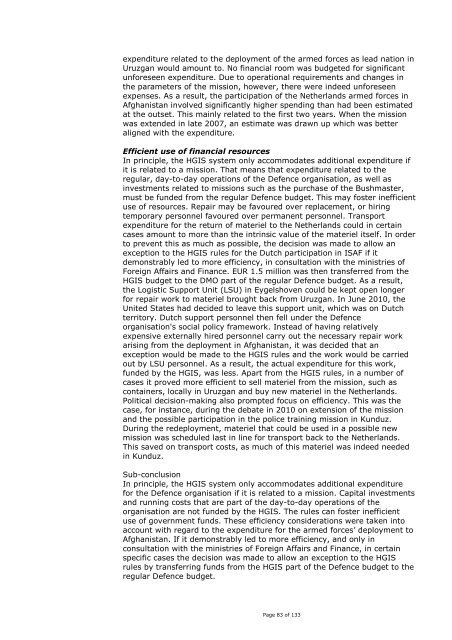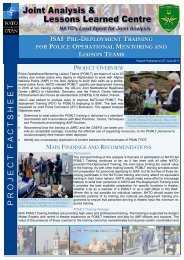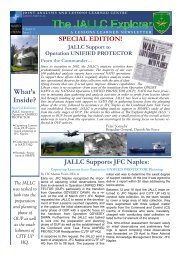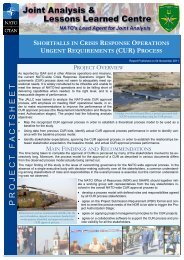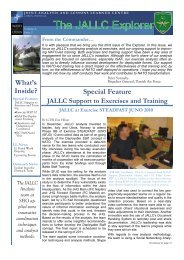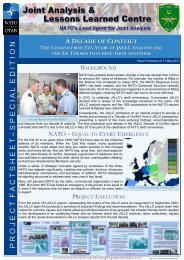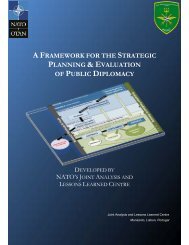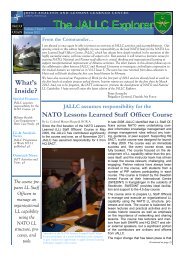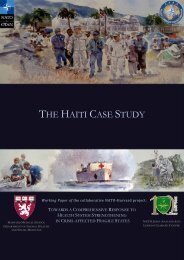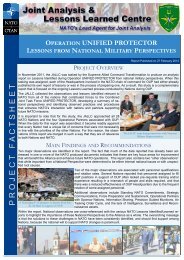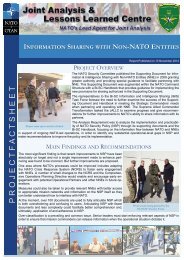Uruzgan, <strong>in</strong> which the <strong>Netherlands</strong> was also lead nation, proved to <strong>in</strong>volveunforeseen expenditure. There was no data from any past experienceavailable <strong>in</strong> this respect. Unforeseen expenditure arose from operationalrequirements or changed parameters. For <strong>in</strong>stance, for 2007 the estimatewas <strong>in</strong>itially based on a troop strength of 1,200, but dur<strong>in</strong>g the course ofthe year, the number was <strong>in</strong>creased to 1,665. This <strong>in</strong>crease had a directeffect on the expenditure for deployment allowances, food, transport andammunition. The <strong>in</strong>crease <strong>in</strong> expenditure for fuel, oil and lubricants <strong>in</strong> 2008and 2009 compared to previous years was a result of the autonomous<strong>in</strong>crease <strong>in</strong> fuel prices and an <strong>in</strong>crease <strong>in</strong> the number of operations outsidethe compound. For <strong>in</strong>stance, more patrols were needed as a result of theexpansion of the <strong>in</strong>k blot. This was not taken <strong>in</strong>to account <strong>in</strong> the <strong>in</strong>itialestimate. The <strong>in</strong>crease <strong>in</strong> expenditure for <strong>in</strong>frastructure <strong>in</strong> 2008 is partlyrelated to ma<strong>in</strong>tenance at Kamp Holland and Camp Hadrian as a result ofthe decision to extend the mission <strong>in</strong> 2007. These issues led, <strong>in</strong> the first twoyears of the mission, to a discrepancy of EUR 260 million between the <strong>in</strong>itialestimate and the actual expenditure.For the extension period up to August <strong>2010</strong>, there is also a discrepancybetween the estimate and the actual expenditure, but it is considerably lessthan was the case with the <strong>in</strong>itial estimate. In the Article 100 letter of 2007,it was announced that expenditure would be monitored more frequently andthat an adjusted estimate system would be used, based on data from theprevious years’ experience <strong>in</strong> Uruzgan. These adjustments reduced thediscrepancy between the estimates and the actual expenditure. Thediscrepancy which arose <strong>in</strong> this period was the result of the hir<strong>in</strong>g ofunmanned aircraft. This <strong>in</strong>crease is listed <strong>in</strong> 2009 under ‘other expenditure’.This hire was not taken <strong>in</strong>to account <strong>in</strong>itially.Dur<strong>in</strong>g the course of the mission, the estimate of expenditure for theredeployment operation was repeatedly adjusted. In 2005, it was <strong>in</strong>itiallythought that it would take two months to br<strong>in</strong>g back personnel andmateriel. In the Article 100 letter of 2007, it was clear that this was tooambitious. There were no specific parameters with which to plan the periodor for the size of the detachment needed to carry out the redeployment. Anprovisional sum was therefore <strong>in</strong>itially <strong>in</strong>cluded. Once the plann<strong>in</strong>g of theredeployment had started, a detailed estimate was made. It was based on alarge-scale Redeployment Task Force (RDTF), <strong>in</strong>clud<strong>in</strong>g capacity for thedetection and disarm<strong>in</strong>g of IEDs, and with the F-16s and helicopters forprotection. It was also acknowledged that, after return<strong>in</strong>g to the<strong>Netherlands</strong>, the deployed materiel would require ma<strong>in</strong>tenance and repair,which meant that expenditure would run on until 2012. The amount <strong>in</strong>itiallyestimated <strong>in</strong> April <strong>2010</strong> for the redeployment was EUR 229 million. Dur<strong>in</strong>gthe first few months of the redeployment, it became clear that there wereways to complete the operation more quickly and with fewer personnel.Partner countries proved will<strong>in</strong>g to provide more force protection than waspreviously foreseen and they were also will<strong>in</strong>g to take over materiel. On theother hand, the security situation required more air transport, which drovethe transport costs up. In September <strong>2010</strong>, it was therefore decided thatthe RDTF estimate would be adjusted to EUR 211 million. It is too early toform a more detailed f<strong>in</strong>ancial judgement on the redeployment, as spend<strong>in</strong>g<strong>in</strong> this respect is still ongo<strong>in</strong>g. This <strong>in</strong>cludes repair work be<strong>in</strong>g carried out onthe materiel which has been brought back from Afghanistan.Sub-conclusionThere is a significant discrepancy between the <strong>in</strong>itial estimates and theactual expenditure funded by the HGIS. When the <strong>in</strong>itial estimate wasdrawn up <strong>in</strong> 2005, there was too little <strong>in</strong>sight <strong>in</strong>to what the actualPage 82 of 133
expenditure related to the deployment of the armed forces as lead nation <strong>in</strong>Uruzgan would amount to. No f<strong>in</strong>ancial room was budgeted for significantunforeseen expenditure. Due to operational requirements and changes <strong>in</strong>the parameters of the mission, however, there were <strong>in</strong>deed unforeseenexpenses. As a result, the <strong>participation</strong> of the <strong>Netherlands</strong> armed forces <strong>in</strong>Afghanistan <strong>in</strong>volved significantly higher spend<strong>in</strong>g than had been estimatedat the outset. This ma<strong>in</strong>ly related to the first two years. When the missionwas extended <strong>in</strong> late 2007, an estimate was drawn up which was betteraligned with the expenditure.Efficient use of f<strong>in</strong>ancial resourcesIn pr<strong>in</strong>ciple, the HGIS system only accommodates additional expenditure ifit is related to a mission. That means that expenditure related to theregular, day-to-day operations of the Defence organisation, as well as<strong>in</strong>vestments related to missions such as the purchase of the Bushmaster,must be funded from the regular Defence budget. This may foster <strong>in</strong>efficientuse of resources. Repair may be favoured over replacement, or hir<strong>in</strong>gtemporary personnel favoured over permanent personnel. Transportexpenditure for the return of materiel to the <strong>Netherlands</strong> could <strong>in</strong> certa<strong>in</strong>cases amount to more than the <strong>in</strong>tr<strong>in</strong>sic value of the materiel itself. In orderto prevent this as much as possible, the decision was made to allow anexception to the HGIS rules for the Dutch <strong>participation</strong> <strong>in</strong> <strong>ISAF</strong> if itdemonstrably led to more efficiency, <strong>in</strong> consultation with the m<strong>in</strong>istries ofForeign Affairs and F<strong>in</strong>ance. EUR 1.5 million was then transferred from theHGIS budget to the DMO part of the regular Defence budget. As a result,the Logistic Support Unit (LSU) <strong>in</strong> Eygelshoven could be kept open longerfor repair work to materiel brought back from Uruzgan. In June <strong>2010</strong>, theUnited States had decided to leave this support unit, which was on Dutchterritory. Dutch support personnel then fell under the Defenceorganisation's social policy framework. Instead of hav<strong>in</strong>g relativelyexpensive externally hired personnel carry out the necessary repair workaris<strong>in</strong>g from the deployment <strong>in</strong> Afghanistan, it was decided that anexception would be made to the HGIS rules and the work would be carriedout by LSU personnel. As a result, the actual expenditure for this work,funded by the HGIS, was less. Apart from the HGIS rules, <strong>in</strong> a number ofcases it proved more efficient to sell materiel from the mission, such asconta<strong>in</strong>ers, locally <strong>in</strong> Uruzgan and buy new materiel <strong>in</strong> the <strong>Netherlands</strong>.Political decision-mak<strong>in</strong>g also prompted focus on efficiency. This was thecase, for <strong>in</strong>stance, dur<strong>in</strong>g the debate <strong>in</strong> <strong>2010</strong> on extension of the missionand the possible <strong>participation</strong> <strong>in</strong> the police tra<strong>in</strong><strong>in</strong>g mission <strong>in</strong> Kunduz.Dur<strong>in</strong>g the redeployment, materiel that could be used <strong>in</strong> a possible newmission was scheduled last <strong>in</strong> l<strong>in</strong>e for transport back to the <strong>Netherlands</strong>.This saved on transport costs, as much of this materiel was <strong>in</strong>deed needed<strong>in</strong> Kunduz.Sub-conclusionIn pr<strong>in</strong>ciple, the HGIS system only accommodates additional expenditurefor the Defence organisation if it is related to a mission. Capital <strong>in</strong>vestmentsand runn<strong>in</strong>g costs that are part of the day-to-day operations of theorganisation are not funded by the HGIS. The rules can foster <strong>in</strong>efficientuse of government funds. These efficiency considerations were taken <strong>in</strong>toaccount with regard to the expenditure for the armed forces’ deployment toAfghanistan. If it demonstrably led to more efficiency, and only <strong>in</strong>consultation with the m<strong>in</strong>istries of Foreign Affairs and F<strong>in</strong>ance, <strong>in</strong> certa<strong>in</strong>specific cases the decision was made to allow an exception to the HGISrules by transferr<strong>in</strong>g funds from the HGIS part of the Defence budget to theregular Defence budget.Page 83 of 133
- Page 1 and 2:
Final evaluationNetherlands contrib
- Page 3 and 4:
High mountainsLow mountainsPlains a
- Page 5 and 6:
Table of ContentsDutch military per
- Page 7 and 8:
Dutch military personnel deceased i
- Page 9 and 10:
Page 9 of 133
- Page 11 and 12:
1 IntroductionThe government would,
- Page 13 and 14:
The structure of the final evaluati
- Page 15 and 16:
2 The international presence in Afg
- Page 17 and 18:
insurgents in, particularly, the ea
- Page 19 and 20:
3 Netherlands policy for participat
- Page 21 and 22:
Netherlands’ presence. Furthermor
- Page 23 and 24:
“The objectives of this stabilisa
- Page 25 and 26:
In December 2005, the Netherlands g
- Page 27 and 28:
The expectation is that meaningful
- Page 29 and 30:
3.6.2 Implementation of national pr
- Page 31 and 32: 4 Implementation of the mission and
- Page 33 and 34: tasks to fulfil in the area of secu
- Page 35 and 36: such as the Bushmaster, that was be
- Page 37 and 38: Afghan partner unit, at all times o
- Page 39 and 40: northern part of Deh Rawod in 2007.
- Page 41 and 42: in large and small bases, while con
- Page 43 and 44: previously thought and comprised a
- Page 45 and 46: Apart from facilitating training an
- Page 47 and 48: If operations in close proximity of
- Page 49 and 50: As previously mentioned, the preven
- Page 51 and 52: - Between 2006 and 2010, the number
- Page 53 and 54: government of Chora in January 2010
- Page 55 and 56: At the beginning of the Dutch missi
- Page 57 and 58: intermediary of TLO and political a
- Page 59 and 60: interest for filling judicial posit
- Page 61 and 62: During the Uruzgan mission, a great
- Page 63 and 64: structurally change governance in U
- Page 65 and 66: development programmes. Before the
- Page 67 and 68: also the way in which Afghans perce
- Page 69 and 70: tailored to the real needs of the p
- Page 71 and 72: Gizab had increased and there was a
- Page 73 and 74: The DCU programme devoted and still
- Page 75 and 76: purpose of these loans, cooperative
- Page 77 and 78: In view of the lack of enthusiasm a
- Page 79 and 80: 5 Expenditure for the mission and i
- Page 81: Overview of long-term expenditure a
- Page 85 and 86: Multi-year expenditure, Foreign Aff
- Page 87 and 88: explosive ordnance disposal, armour
- Page 89 and 90: this situation as constraining, for
- Page 91 and 92: organised at a later stage. In addi
- Page 93 and 94: occupational social workers and the
- Page 95 and 96: Mercedes Benz terrain vehicle, the
- Page 97 and 98: 6 ConclusionsThis chapter begins wi
- Page 99 and 100: The first part of the central quest
- Page 101 and 102: At the end of 2005, the Afghan auth
- Page 103 and 104: province. This, too, was done by me
- Page 105 and 106: area, increased sales of agricultur
- Page 107 and 108: ISAF and the OEF led to extra coord
- Page 109 and 110: d. The recommendations from advisor
- Page 111 and 112: Page 111 of 133
- Page 113 and 114: Annex A, Afghanistan Compact Benchm
- Page 115 and 116: end-2010, reforms will strengthen t
- Page 117 and 118: Afghan Cultural HeritageA comprehen
- Page 119 and 120: Private Sector Development and Trad
- Page 121 and 122: Annex B, Results of the socio-econo
- Page 123 and 124: EducationTLO data:• In 2006 there
- Page 125 and 126: Overview of the number of children
- Page 127 and 128: Annex C, Chronology200522 December:
- Page 129 and 130: July: microcredit provider World Co
- Page 131 and 132: Annex D, List of abbreviations3DADZ
- Page 133:
Page 133 of 133


